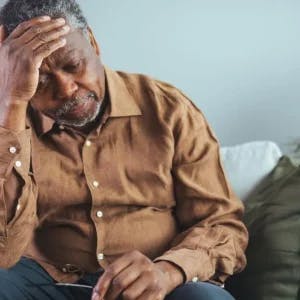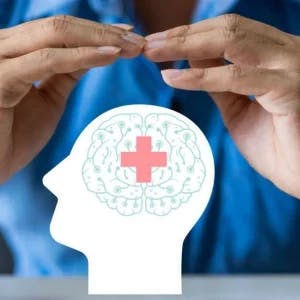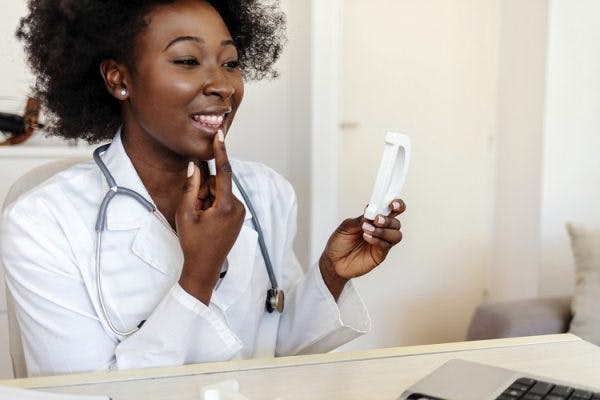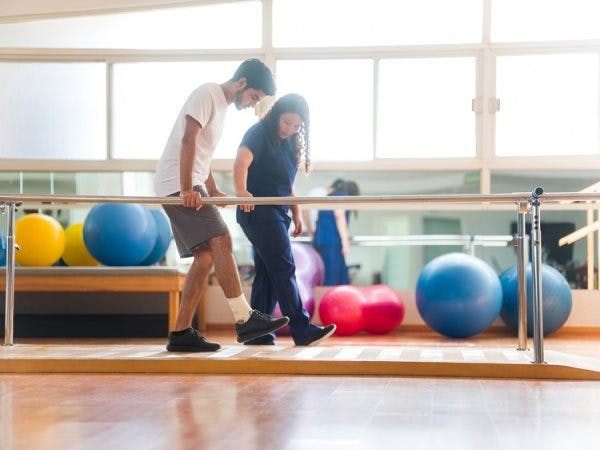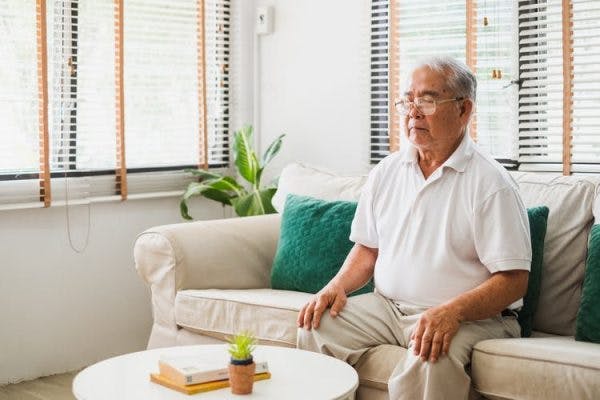Incontinence after stroke is relatively common, affecting nearly half of all acute stroke survivors. This is because a stroke can alter the ability to effectively control the muscles involved with bowel and bladder functions.
While incontinence after stroke can be distressing, it is important for survivors to remember that it is a common secondary effect of stroke that can often be treated. In fact, many individuals with urinary incontinence experience spontaneous recovery by 8 weeks post-stroke, and only 19% continue to experience incontinence 6 months after their stroke.
This article will provide an overview of how to manage incontinence after stroke. Use the links below to jump directly to any section:
- What Is Incontinence After Stroke?
- Tips for Dealing with Incontinence After Stroke
- Rehabilitation for Incontinence
- Other Treatment Options
What Is Incontinence After Stroke?
Incontinence can be defined as an involuntary loss of urine from the bladder (urinary incontinence) or the unconscious passing of feces from the bowel (fecal incontinence). There are a number of symptoms that individuals with incontinence may experience. While unintentional leakage is most common among stroke survivors, some individuals may experience a complete loss of bowel and bladder control. Other symptoms of incontinence include:
- Needing to use the bathroom very frequently
- The urge to use the bathroom immediately
- Difficulty with emptying the bladder completely, known as urinary retention
- Needing to use the bathroom multiple times overnight
- Constipation or diarrhea
- Functional challenges (such as difficulty managing pants) that impede the ability to use the toilet in a timely manner
Individuals may experience incontinence after stroke when the area(s) of the brain responsible for controlling bladder and bowel functions become damaged. While the exact areas of the brain involved in bowel and bladder control are still being studied, individuals with incontinence often have experienced damage to the prefrontal cortex of the frontal lobe. Damage to the brainstem (particularly the pons), parietal lobe, temporal lobe, and internal capsule may also result in incontinence.
Factors that place individuals at an increased risk of incontinence after stroke include:
- High severity of stroke
- Having a hemorrhagic stroke
- Demonstrating lower functional independence and/or requiring caregiver assistance
- Experiencing other secondary effects of stroke (such as aphasia, dysphagia, eye movement disorders, depression, or leg movement disorders)
- Chronic cough
Urinary incontinence tends to be more prevalent after stroke than fecal incontinence, although some survivors experience both. While incontinence is relatively common during the initial recovery period after stroke, it often resolves with time and/or appropriate treatment.
Tips for Dealing with Incontinence After Stroke
Because incontinence after stroke can significantly affect one’s quality of life, it is essential to be prepared to prevent or handle accidents. Here are a few useful tips for dealing with the challenges that come with incontinence:
- Plan for extra time to get to the bathroom
- Wear pants that are easy to get off quickly (such as elastic waist pants)
- Keep an extra set of clothing in the bathroom and in the car
- Use undergarments that can be thrown away, if needed
- Have hand wipes and sanitizer nearby at all times
- Add waterproof pads beneath bedsheets
- Protect furniture with plastic covers
- Arrange the living room to have a comfortable seating area on the side of the room nearest to the bathroom
These tips can help individuals deal with the unavoidable results of incontinence. However, seeking treatment can lessen the possibility experiencing incontinence, both at home and in public.
Rehabilitative Methods to Improve Continence
In some stroke survivors, incontinence resolves on its own after a short amount of time. This is known as spontaneous recovery. However, if incontinence persists, there are a number of treatments available.
One of the best methods to improve incontinence after stroke is working with an occupational or physical therapist, particularly one who specializes in pelvic floor therapy. Therapy sessions may consist of practicing specific exercises and therapeutic techniques to improve communication between the brain and the bowel and bladder muscles.
Practicing targeted repetitive exercises can stimulate neuroplasticity, the process that the brain uses to create and strengthen neural pathways. Therefore, when exercises designed to improve bowel and bladder control are practiced consistently, neuroplasticity becomes activated. This promotes adaptive rewiring in the brain, allowing undamaged areas of the brain to assume control of functions that were previously housed in areas affected by the stroke.
Here are a few exercises and techniques that therapists may recommend to recover from incontinence:
Pelvic Floor Training
Participating in pelvic floor training can help strengthen the muscles that support the bladder, small intestine, and rectum. Kegel exercises are one of the most commonly recommended pelvic floor training techniques.
To perform a Kegel exercise, try to squeeze only the muscles that are used to stop the flow of urine for 3 seconds, then relax for 10-20 seconds. Continue this for 10 reps, adding one second to each repetition as able.
Bladder/Bowel Retraining
The purpose of bladder/bowel retraining programs is to gradually train the bladder and bowels to hold more for longer periods of time. To start, make a schedule of specific times to use to the restroom. The initial schedule should be relatively frequent, as the goal is prevent episodes of incontinence between bathroom breaks.
As continence improves, gradually increase the amount of time between each bathroom visit until there are approximately 2-3 hours between scheduled bathroom breaks. A therapist can help design and adapt a bladder/bowel retraining program specific to the survivor’s current abilities.
Urgency Control
Practicing strategies such as deep breathing and/or complex mental tasks, like counting down from 100, can help distract individuals from feeling like they need to urgently relieve themselves. Using urgency control strategies can help individuals extend the amount of time between bathroom breaks and reduce the need to go immediately upon feeling an urge.
Electrical Stimulation
Therapists may also recommend using electrical stimulation (e-stim) to improve bowel and bladder control. This may involve using an e-stim device, such as a TENS unit, or participating in techniques like electroacupuncture, where an electrical current is transmitted through specific points on the body through small needles. While still being researched, both of these treatments have shown promising results for improving continence after stroke.
Managing Secondary Conditions
There is an increased risk of incontinence among survivors experiencing certain secondary effects of stroke, such as aphasia, leg weakness, and vision problems. Addressing these conditions may improve continence.
For example, individuals with aphasia may experience episodes of incontinence if they cannot easily verbalize the need to dismiss themselves from a situation to use the bathroom. Learning to communicate this need with others, whether through improving speech or using alternative communication methods, may help to improve continence. Similarly, in survivors with leg weakness or vision problems, improving these skills may help individuals get to the bathroom in a timely manner.
Environmental Modifications
Creating an accessible bathroom can also help to limit episodes of incontinence. If incontinence often occurs due to the physical demands of getting to the toilet, a therapist may recommend utilizing certain types of equipment, such as a grab bar, a raised toilet seat, or, in severe cases, a portable commode toilet. Walkers, canes and lift chairs may also improve the ability to safely and quickly make it to the bathroom.
Other Treatments for Incontinence After Stroke
In addition to rehabilitation, there are a number of other treatments for incontinence after stroke that may be recommended. Although treatments vary depending on the type of incontinence, here are a few of the most common recommendations:
- Avoiding coffee and alcohol, which make individuals produce more urine, can help prevent urinary incontinence. However, it is important to continue drinking an adequate amount of water and other fluids, unless otherwise indicated.
- Making dietary changes to reduce constipation can help, as constipation worsens fecal incontinence. Adding stool softeners or laxatives while avoiding low fiber foods (like cheese) can also improve symptoms.
- Losing weight can help with incontinence, as being overweight can affect the ability to control the bladder.
- Following a bowel and bladder program involves using a schedule to stimulate bowel and bladder movements rather than waiting until having the urge to use the toilet.
- Taking medication can help improve continence in a number of ways, including reducing the urge to use the bathroom, increasing the amount of urine the bladder can hold, and decreasing diarrhea and/or constipation.
- Catheter placement or surgery may be recommended as a last resort for individuals experiencing severe and persistent incontinence.
Because there are so many different symptoms of incontinence that stroke survivors may experience, these treatments may not be effective or recommended for everyone. While many individuals may benefit from one or more of the treatments above, survivors should work closely with their physician, rehabilitative nurses, and therapist to determine the best incontinence treatment plan.
Addressing Incontinence After Stroke
Incontinence is a common secondary effect of stroke that may occur due to damage to the areas of the brain that control the bowel and bladder muscles. With appropriate treatment and management interventions, many individuals regain control over their bowel and bladder muscles, which significantly improves their quality of life.
In many survivors, continence is regained spontaneously. However, for those who experience persistent incontinence, participating in rehabilitation, using medical interventions and making beneficial lifestyle choices can help survivors improve continence. Survivors experiencing difficulties with incontinence should talk with their doctor or therapist for more personalized recommendations regarding how to address incontinence after stroke.




